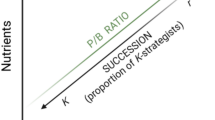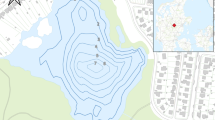Abstract
Turbidity influences the success of fish feeding, but little is known about the difference in the effects of turbidity as a result of organic and inorganic matter. To assess the feeding behaviour of a native fish, Goodea atripinnis, under turbid conditions (up to 120 NTU) generated by Microcystis aeruginosa or silt, we conducted mesocosm experiments for 25 days using 40-L plastic mesocosms. Each tank received two G. atripinnis individuals (predators) with a mean total length 61 mm and cladoceran zooplankton (prey) (Alona glabra, Chydorus sphaericus, Moina macrocopa, Simocephalus vetulus, Ceriodaphnia dubia, and Daphnia pulex) of 100 ind. L−1. Filtered water from Xochimilco Lake was used to fill the mesocosms. Goodea atripinnis had a selective effect on the zooplankton community in the form of a decrease in the number of pelagic cladocerans. The zooplankton composition, which was least affected by the fish, included small-sized (400–480 µm) benthic cladocerans (e.g. Chydorus sphaericus) and copepods (both calanoids and cyclopoids). Prey consumption by the fish was highest under conditions with inorganic turbidity, while in the fishless treatments, small cladocerans (along with calanoids) had a high density. Organic turbidity offered refuge against fish predation to A. glabra, C. sphaericus, Daphnia pulex, M. alburquerquensis and A. americanus, whereas inorganic turbidity allowed only both test copepods to coexist in the presence of fish. The results suggest that fish predation is a powerful factor regulating zooplankton communities, even in highly turbid waters.



Similar content being viewed by others
References
Abrahams MV, Kattenfeld MG (1997) The role of turbidity as a constraint on predator-prey interactions in aquatic environments. Behav Ecol Sociobiol 40:169–174. https://doi.org/10.1007/s002650050330
Bruton MN (1985) The effects of suspensoids on fish. Hydrobiologia 125:221–241. https://doi.org/10.1007/978-94-009-5522-6_16
Carpenter SR, Kitchell KL (1993) The trophic cascade in lakes. Cambridge University, Cambridge
Chacón-Torres A (1993) Lake Patzcuaro, Mexico: watershed and water quality deterioration in a tropical high-altitude Latin American lake. Lake Reserv Manage 8:37–47. https://doi.org/10.1080/07438149309354457
Chang KH, Nagata T, Hanazato T (2004) Direct and indirect impacts of predation by fish on the zooplankton community: an experimental analysis using mesocosms. Limnology 5:121–124. https://doi.org/10.1007/s10201-004-0116-7
De Robertis A, Ryer CH, Veloza A, Brodeur RD (2003) Differential effects of turbidity on prey consumption of piscivorous and planktivorous fish. Can J Fish Aquat Sci 60:1517–1526. https://doi.org/10.1139/f03-123
Domínguez-Domínguez O, Nandini S, Sarma SSS (2002) Larval Behaviour of the endangered golden bumblebee goodeid. Allotoca dugesi, implications for conservation of an endangered species. Fish Manag Ecol 9:285–291. https://doi.org/10.1046/j.1365-2400.2002.00309.x
Donohue I, Garcia-Molinos J (2009) Impacts of increased sediment loads on the ecology of lakes. Biol Rev 84:517–531. https://doi.org/10.1111/j.1469-185X.2009.00081.x
Drenner RW, McComas SR (1980) The roles of zooplankter escape ability and fish size selectivity in the selective feeding and impact of planktivorous fish. In: Kerfoot WC (ed) Evolution and ecology of zooplankton communities. University of New England Press, Hanover, pp 587–593
Engström J, Viherluoto M, Viitasalo M (2001) Effects of toxic and non-toxic cyanobacteria on grazing, zooplanktivory and survival of the mysid shrimp Mysis mixta. J Exp Mar Biol Ecol 257:269–280. https://doi.org/10.1016/S0022-0981(00)00339-7
Enríquez-García C, Nandini S, Sarma SSS (2009) Seasonal dynamics of zooplankton in Lake Huetzalin, Xochimilco (Mexico City, Mexico). Limnologica 39:283291. https://doi.org/10.1016/j.limno.2009.06.010
Escalera-Vazquez LH, Dominguez-Dominguez O, Sarma SSS, Nandini S (2004) Selective feeding on zooplankton by larval Skiffia multipunctata (Goodeidae). J Freshw Ecol 19:433–439. https://doi.org/10.1080/02705060.2004.9664916
Fey SB, Cottingham KL (2012) Thermal sensitivity predicts the establishment success of nonnative species in a mesocosm warming experiment. Ecology 93:2313–2320. https://doi.org/10.1890/12-0609.1
Figueroa-Sanchez MA, Nandini S, Sarma SSS (2014) Zooplankton community structure in the presence of low levels of cyanotoxins: a case study in a high altitude tropical reservoir (Valley de Bravo, Mexico). J Limnol 73:157–166. https://doi.org/10.4081/jlimnol.2014.784
Gayosso-Morales MA, Nandini S, Martínez-Jeronimo FF, Sarma SSS (2017) Effect of organic and inorganic turbidity on the zooplankton community structure of a shallow waterbody in Central Mexico (Lake Xochimilco, Mexico). J Environ Biol 38:1183–1196. https://doi.org/10.22438/jeb/38/6(SI)/03
Gerking SD (1994) Feeding ecology of fish. Academic Press, Cambridge, p 416
Gliwicz ZM, Pijanowska J (1989) The role of predation in zooplankton succession. In: Sommer U (ed) Plankton ecology. Springer Verlag, London, pp 253–296
Gregory RS, Northcote TG (1993) Surface, planktonic, and benthic foraging by juvenile chinook salmon (Oncorhynchus tshawytscha) in turbid laboratory conditions. Can J Fish Aquat Sci 50:233–240. https://doi.org/10.1139/cjfas-2015-0555
Guthrie DM, Muntz WRA (1993) Role of vision in fish behaviour. In: Pitcher TP (ed) Behaviour of teleost fishes. Chapman and Hall, London, pp 89–121
Hessen DO, Faafeng BA, Smith VH, Bakkestuen V, Walseng B (2006) Extrinsic and intrinsic controls of zooplankton diversity in lakes. Ecology 87:433–443. https://doi.org/10.1890/05-0352
Jeppesen E, Jensen JP, Søndergaard M, Lauridsen T, Landkildehus F (2000) Trophic structure, species richness and biodiversity in Danish lakes: changes along a phosphorus gradient. Freshw Biol 45:201–218. https://doi.org/10.1046/j.1365-2427.2000.00675.x
Jeppesen E, Søndergaard M, Mazzeo N, Meerhoff M, Branco C, Huszar V, Scasso F (2005) Lake restoration and biomanipulation in temperate lakes: relevance for subtropical and tropical lakes. In: Reddy V (ed) Tropical eutrophic lakes: their restoration and management. Science Publishers Inc, Enfield, pp 341–359
Kamjunke N, Mehner T (2001) Coupling the microbial food web with fish: are bacteria attached to cyanobacteria an important food source for underyearling roach? Freshw Biol 46:633–639. https://doi.org/10.1046/j.1365-2427.2001.00701.x
Kamjunke N, Schmidt K, Pflugmacher S, Mehner T (2002) Consumption of cyanobacteria by roach (Rutilus rutilus): useful or harmful to the fish? Freshw Biol 47:243–250. https://doi.org/10.1046/j.1365-2427.2002.00800.x
Keshavanath P, Beveridge MC, Baird DJ, Lawton LA, Nimmo A, Codd GA (1994) The functional grazing response of a phytoplanktivorous fish Oreochromis niloticus to mixtures of toxic and non-toxic strains of the cyanobacterium Microcystis aeruginosa. J Fish Biol 45:123–129. https://doi.org/10.1111/j.1095-8649.1994.tb01291.x
Koste W (1978) Rotatoria. Borntraeger, Berlin
Krebs JR, Davies NB (1993) Behavioural ecology. An evolutionary approach. Wiley, London
Lynch M (1979) Predation, competition, and zooplankton community structure: an experimental study. Limnol Oceanogr 24:253–272. https://doi.org/10.4319/lo.1979.24.2.0253
Lyons J, Gutierrez-Hernandez A, Díaz-Pardo E, Soto-Galera E, Medina-Nava M, Pineda-Lopez R (2000) Development of a preliminary index of biotic integrity (IBI) based on fish assemblages to assess ecosystem condition in the lakes of central Mexico. Hydrobiologia 418:57–72. https://doi.org/10.1023/A:1003888032756
Maes J, Taillieu A, Van Damme K, Cottenie K, Ollevier F (1998) Seasonal patterns in the fish and crustacean community of a turbid temperate estuary. Estuar Coast Shelf Sci 47:143–151. https://doi.org/10.1006/ecss.1998.0350
Meager JJ, Batty RS (2007) Effects of turbidity on the spontaneous and prey-searching activity of juvenile Atlantic cod (Gadus morhua). Philos Trans R Soc Lond B Biol Sci 362:2123–2130. https://doi.org/10.1098/rstb.2007.2104
Mercado-Silva N, Helmus MR, Zanden M (2009) The effects of impoundment and non-native species on a river food web in Mexico’s central plateau. River Res Appl 25:1090–1108. https://doi.org/10.1002/rra.1205
Miller RR, Minckley WL, Norris S, StevenMark M (2009) Freshwater fishes of Mexico. University of Chicago Press, Chicago, p 490
Miranda R, Galicia D, Monks S, Pulido-Flores G (2010) First record of Goodea atripinnis (Cyprinodontiformes: Goodeidae) in the state of Hidalgo (Mexico) and some considerations about its taxonomic position. Hidrobiológica 20:185–190
Nandini S, Ramírez-García P, Sarma SSS (2016) Water quality indicators in Lake Xochimilco, Mexico: zooplankton and Vibrio cholera. J Limnol 75(1):91–100. https://doi.org/10.4081/jlimnol.2015.1213
Niemisto J, Tallberg P, Horppila J (2005) Sedimentation and resuspension-factors behind the clay-turbidity in Lake Hiidenvesi. Adv Limnol 59:25–38
Nurminen L, Pekcan-Hekim Z, Horppila J (2010) Feeding efficiency of planktivorous perch Perca fluviatilis and roach Rutilus rutilus in varying turbidity: an individual-based approach. J Fish Biol 76:1848–1855. https://doi.org/10.1111/j.1095-8649.2010.02600.x
Pace ML (1986) An empirical analysis of zooplankton community size structure across lake trophic gradients. Limnol Oceanogr 31:45–55. https://doi.org/10.4319/lo.1986.31.1.0045
Parkos JJ, Santucci VJ, Wahl DH (2003) Effects of adult common carp (Cyprinus carpio) on multiple trophic levels in shallow mesocosms. Can J Fish Aquat Sci 60:182–192. https://doi.org/10.1139/f03-011
Pekcan-Hekim Z, Lappalainen J (2006) Effects of clay turbidity and density of pikeperch (Sander lucioperca) larvae on predation by perch (Perca fluviatilis). Naturwissenschaften 93:356–359. https://doi.org/10.1007/s00114-006-0114-1
Peña-Aguado F, Nandini S, Sarma SSS (2009) Functional response of Ameca splendens (Family Goodeidae) fed cladocerans during the early larval stage. Aquacult Res 40:1594–1604. https://doi.org/10.1111/j.1365-2109.2009.02259.x
Pepin P, Penney RW (1997) Patterns of prey size and taxonomic composition in larval fish: are there general size-dependent models? J Fish Biol 51:84–100. https://doi.org/10.1111/j.1095-8649.1997.tb06094.x
Peredo-Alvarez VM, Sarma SSS, Nandini S (2004) Studies on the functional responses of the Mexican live bearer fish Allotoca meeki (Goodeidae: Cyprinodontiformes). Adv Fish Wildl Ecol Biol 3:27–40
Picapedra PHS, Sanches PV, Lansac-Tôha FA (2018) Effects of light-dark cycle on the spatial distribution and feeding activity of fish larvae of two co-occurring species (Pisces: Hypophthalmidae and Sciaenidae) in a Neotropical floodplain lake. Braz J Biol 78:763–772. https://doi.org/10.1590/1519-6984.179070
Radke RJ, Gaupisch A (2005) Effects of phytoplankton-induced turbidity on predation success of piscivorous Eurasian perch (Perca fluviatilis): possible implications for fish community structure in lakes. Naturwissenschaften 92:91–94. https://doi.org/10.1007/s00114-004-0596-7
Reid SM, Fox MG, Whillans TH (1999) Influence of turbidity on piscivory in largemouth bass (Micropterus salmoides). Can J Fish Aquat Sci 56:1362–1369. https://doi.org/10.1139/f99-056
Schwartz JS, Dahle M, Robinson BR (2008) Concentration-duration frequency curves for stream turbidity: possibilities for assessing biological impairment. J Am Water Resour Assoc 44:879–886. https://doi.org/10.1111/j.1752-1688.2008.00186.x
Shoup DE, Wahl DH (2009) The effects of turbidity on prey selection by piscivorous largemouth bass. Trans Am Fish Soc 138:1018–1027. https://doi.org/10.1577/T09-015.1
Smirnov NN (1974) Fauna of the U.S.S.R. Crustacea. Keter Publishing House, Jerusalem
Smith VH (2003) Eutrophication of freshwater and coastal marine ecosystems a global problem. Environ Sci Pollut Res 10:126–139. https://doi.org/10.1065/espr2002.12.142
Sohel S, Mattila J, Lindström K (2017) Effects of turbidity on prey choice of three-spined stickleback Gasterosteus aculeatus. Mar Ecol Progr Ser 566:159–167. https://doi.org/10.3354/meps12014
Soto D, Hurlbert SH (1991) Long-term experiments on calanoid–cyclopoid interactions. Ecol Monogr 61:245–266. https://doi.org/10.2307/2937108
Stowasser A, Buschbeck EK (2012) Electrophysiological evidence for polarization sensitivity in the camera-type eyes of the aquatic predacious insect larva Thermonectus marmoratus. J Exp Biol 215:3577–3586. https://doi.org/10.1242/jeb.075028
Sweka JA, Hartman KJ (2003) Reduction of reactive distance and foraging success in smallmouth bass, Micropterus dolomieu, exposed to elevated turbidity levels. Environ Biol Fish 67:341–347. https://doi.org/10.1023/A:1025835031366
Ter Braak CJ, Smilauer P (2002) CANOCO reference manual and CanoDraw for Windows user’s guide: software for canonical community ordination (version 4.5). www.canoco.com
Turesson H, Brönmark C (2007) Predator–prey encounter rates in freshwater piscivores: effects of prey density and water transparency. Oecologia 153:281–290. https://doi.org/10.1007/s00442-007-0728-9
Utne-Palm AC (2002) Visual feeding of fish in a turbid environment: physical and behavioural aspects. Mar Freshw Behav Phyiol 35:111–128. https://doi.org/10.1080/10236240290025644
Vinyard GL, O’Brien WJ (1976) Effects of light and turbidity on the reactive distance of bluegill (Lepomis macrochirus). J Fish Res Board Can 33:2845–2849. https://doi.org/10.1139/f76-342
Yoshida T, Kagami M, Gurung TB, Urabe J (2001) Seasonal succession of zooplankton in the north basin of Lake Biwa. Aquat Ecol 35:19–29. https://doi.org/10.1023/A:1011498202050
Acknowledgements
Manuel A. Gayosso-Morales thanks the Mexican Council for Science and Technology (CONACyT-211276) for a doctoral scholarship and Instituto Politécnico Nacional, ENCB for additional help and support. SN and SSSS thank PAPIIT (UNAM) (IN216315, IN219218, and IN214618) for financial assistance. FMJ is grateful to EDI-IPN and COFAA-IPN for the partial support to this project.
Funding
PAPIIT (UNAM) (IN216315, IN219218 and IN214618). EDI-IPN and COFAA-IPN for the partial support to this project.
Author information
Authors and Affiliations
Corresponding author
Additional information
Publisher's Note
Springer Nature remains neutral with regard to jurisdictional claims in published maps and institutional affiliations.
Rights and permissions
About this article
Cite this article
Gayosso-Morales, M.A., Nandini, S., Martínez-Jeronimo, F.F. et al. Fish-mediated zooplankton community structure in shallow turbid waters: a mesocosm study. Wetlands Ecol Manage 27, 651–661 (2019). https://doi.org/10.1007/s11273-019-09684-1
Received:
Accepted:
Published:
Issue Date:
DOI: https://doi.org/10.1007/s11273-019-09684-1




